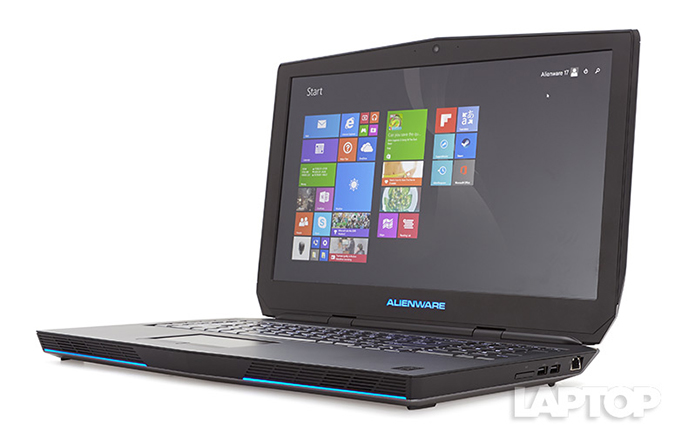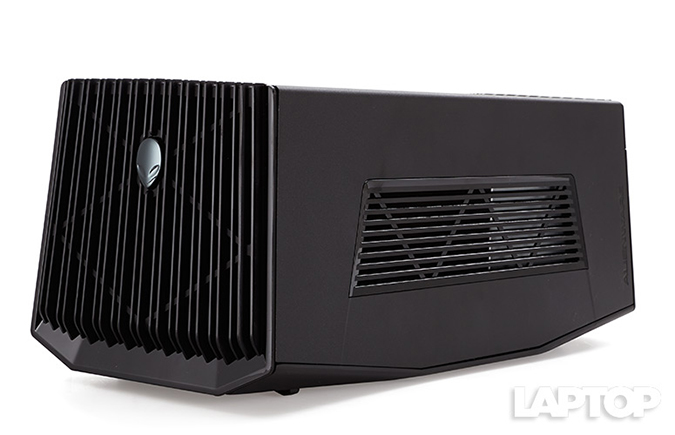Laptop Mag Verdict
The Alienware 17 gets updated with an Nvidia GeForce 980M GPU and an optional graphics amplifier for unrivaled gaming power.
Pros
- +
Sexy, futuristic chassis
- +
Lovely 1080p display
- +
Good performance
- +
Graphics amp significantly boosts GPU performance
- +
Superb battery life for gaming laptop
Cons
- -
Muddy audio quality
- -
Runs hot
Why you can trust Laptop Mag
Subtlety has never been Alienware's strong suit, but with this iteration of the brand's 17-inch gaming laptop, it's what you don't see that deserves the biggest praise. This time around, the Alienware 17 ($2,299 as configured, starting at $1,499) has Nvidia's GeForce GTX 980M GPU under the hood, giving the system a serious graphics boost.
But if Nvidia's top mobile GPU doesn't satisfy your frame-rate lust, you can unlock even more power with Alienware's optional graphics amplifier, which, when paired with a desktop GPU, unlocks a whole new level of kick-ass.
Design
I've now reviewed the Alienware 17 four times, but still get a thrill when I see that extraterrestrial-inspired logo. A pair of LED strips and the backlit alien head emblem add a spark of fun to the otherwise stately gray anodized lid with black plastic trim.

Tracing my fingers along the three intersecting lines on the lid while contemplating my place in the universe is almost cathartic, but fun really begins upon opening the notebook. From there, I'm greeted by an interior awash in black soft-touch finish, and illuminated by a keyboard and touchpad glowing an otherworldly blue. A pair of lights running along the bottom front lip of the notebook enhances the effect.
While the same size as last year's model (17.9 x 12.9 x 2.26-2.23 inches), Alienware managed to shave more than a pound from the Alienware 17, bringing its weight to an even 8 pounds. It's lighter than the MSI GT72 Dominator Pro (8.4 pounds, 16.9 x 11.6 x 1.9 inches) and the ASUS G751JY (9.2 pounds, 16.4 x 12.5 x 0.9~1.7 inches).
Display
The best thing about the Alienware 17 (besides the specs and configurable lighting) is its 17-inch 1080p display. I was awestruck watching the full HD Mad Max: Fury Road trailer. Superheated metal barrels flew through the air, propelled by a growing fireball in brilliant hues of white, yellow, orange and red. Details were so fine that I could make out the pattern on the barrel of the mounted machine gun in the forefront of the scene.

Playing Far Cry 4 on the Alienware 17 was a mesmerizing experience. I watched a Molotov cocktail-wielding maniac clad in blood-red camos run toward me, green bottle glistening in his hand. Shooting the bottle covered the combatant in tangerine and gold flames, which against the clear blue sky made his painful death look disturbingly beautiful.
The Alienware 17 exceeded expectations on our color reproduction test, achieving 106.3 percent of the color gamut. That topped the 96 percent desktop replacement average. The Asus G751JY obtained 99.1 percent, while the MSI Dominator Pro hit 88.5 percent.
When measured for brightness, the Alienware 17 averaged 253 nits, below the 286 nit average. The Dominator Pro was only marginally better at 255 nits, while the G751JY blinded the competition with 304 nits.
Audio
As usual, the pair of Klipsch speakers were loud enough to blanket a medium test space. Something I wasn't accustomed to, however, was boomy, muddy bass emanating from the bottom-mounted subwoofer and flat highs. I encountered both while listening to Janelle Monae's "Yoga." Despite fiddling with the SoundBlaster Recon3D PCIe software and its various equalizer settings, the best I could get was a submerged sound that robbed my ears of Monae's usually bell-like soprano.
The speakers fared better with sound effects, as I quickly learned during my Far Cry 4 play-through. After running for long periods of time, I could hear the heavy thuds of my feet along with the ragged sounds of my breath. After blowing up an enemy convoy, I was rewarded with a weighty boom and the tinkling sounds of the resulting shrapnel.
Keyboard and Touchpad
Typing on the Alienware 17's full-size traditional keyboard (with full num pad and eight macro keys) is one of the best experiences you can get on a gaming laptop, outside of the MSI GT80 Titan SLI's mechanical keyboard. The 2.24 mm of key travel and 62 grams of actuation delivers firm feedback that, coupled with the large soft-touch palm rest, allowed me to let the words flow.

In relation to the massive palm rest, the 4.1 x 2.25-inch Synaptics touchpad looks smaller than it actually is. But the glowing pad's generous dimensions easily accommodated my fingers and offered quick, fluid response for pinch-zoom, two-finger rotate and Windows 8.1 gestures. The two discrete mouse buttons are large and springy.
Alienware Command Center
Central to any gaming rig should be the ability to tweak settings. Alienware's Command Center lets you do just that: you can change the lighting, power settings and program macros via several alien-themed programs.
Want your laptop to glow in alternating pink-and-green waves? Then Alienware's AlienFX software is for you. Comprised of a color wheel featuring 20 hues with three lighting effects, you can customize the laptop's nine zones to your heart's desire. Profiles can be as basic or as complex as you want. Best of all, you can program specific settings for certain game profiles using the AlienAdrenaline utility.
AlienTactX handles the macro keys, enabling gamers to assign color palettes and program keystrokes or shortcuts. To ensure you're getting the best performance from your laptop, you can tweak the power settings via AlienFusion. From there, you can set the hard drive to shut down or create a hybrid sleep state.
Finally, in case of a system crash, AlienRespawn can create backups of your precious game files so your 17 can live to frag another day.
Heat
As cool as the Alienware 17 looks, it can get a little hot. After streaming an episode of Daredevil from Netflix for 15 minutes, the touchpad measured 80 degrees Fahrenheit. The space between the G and H keys and the laptop's undercarriage registered a hot 102 and 112 degrees, respectively. Both temperatures are well above the Laptop Mag comfort threshold of 95 degrees.
Things got even hotter once I started playing Far Cry 4. After of 15 minutes of exploring caves and abandoned houses, the space between the G and H key measured 110 degrees while the middle of the notebook's bottom hit 119 degrees. At least the touchpad remained a fairly cool 82 degrees.
Ports
The Alienware 17 packs ports aplenty, starting with a pair of USB 3.0 ports, an SD Card reader and a Gigabit Ethernet port on the right.

You'll find another couple of USB 3.0 ports, a secure lock slot and jacks for headphones, a microphone and power on the laptop's left. Along the rear of the laptop there's an HDMI port, mini DisplayPort and a proprietary port for the Graphics Amplifier.
Gaming and Graphics
To borrow a phrase from early '80's Nintendo, "now you're playing with power." The updated Alienware 17 boasts Nvidia's top mobile graphics card, the GeForce GTX 980M GPU, along with 4GB of VRAM. It made for beautifully violent encounters in Far Cry 4, where I set a small thicket on fire flushing out a herd of deer while torching an enemy combatant. The orange-red flames danced across his panicking frame until he finally collapsed in a blackened heap among the dying embers. This carnage took place at a smooth 43 frames per second with all they eye candy turned on.
Still, the Alienware 17 didn't fare as well against other notebooks with the same GPU. On the taxing Metro: Last Light, the Alienware posted 58 fps with the effects on low. While on a par with the MSI Dominator Pro (57 fps), that's less than the 75 fps average and the Asus G751JY's 61 fps. At the highest setting, the Alienware 17's frame rate fell to 32 fps, which is enough to defeat the 24 fps average. However, it couldn't top the G751JY or the Dominator Pro, which notched 37 and 34 fps, respectively.
During the 3DMark Fire Strike benchmark, the Alienware 17 hit 8,234, scorching the 5,899 average and edging out the Dominator Pro's 8,228. It was no match, however, for the G751JY and its score of 8,367.
The Alienware 17 is also outfitted with an Intel HD 4600 GPU for those few-and-far between moments of non-gaming activities.
Graphic Amplifier
Two is always better than one, especially when it comes to GPUs. Similar to the Alienware 13 and 15, the new Alienware 17 can be used with the company's 7.7 pound, 16.1 x 6.8 x 7.3-inch graphical amplifier. This powerful but pricey peripheral bypasses the Alienware 17's Nvidia GeForce GTX 980M GPU in favor of a desktop GPU. The amp I tested had an Nvidia GeForce GTX 980 GPU with 4GB of VRAM for a noticeable boost of power. However, Alienware offers several GPU options that add a measure of future-proofing to your laptop.

This time around on the Far Cry 4 benchmark, the Alienware hit 77 fps on low and 86 fps on high, compared with 64 fps and 43 fps with just the laptop's GPU. For Metro: Last Light, the frame rate peaked at 96 fps on low and 46 fps on high; which is better than the 76 fps and 32 fps that the notebook mustered on its own.
In addition to the added power, you also get a bevy of extra ports, including four USB 3.0 ports, three full DisplayPorts, HDMI and a DVI port - allowing you to connect up to four monitors. And, yes, you can tweak the backlit alien's head color with the AlienFX software.
All this awesomeness doesn't come cheap. By itself, the amp costs $174, but doesn't include a GPU. Adding the Nvidia GeForce GTX 960 GPU with 2GB of VRAM is the cheapest option at $199, while a 980 GPU costs $574 and an AMD Radeon HD R9 290X GPU with 4GB will set you back $651.
Performance
If you have to use the Alienware 17 for something other than gaming (looking up walkthroughs or watching/recording a Twitch stream), it's nice to know that the laptop's processor is ready for anything. The 2.5-GHz Intel Core i7-4710HQ CPU with 16GB of RAM nimbly streamed Daredevil on Netflix while performing a full system scan with 13 open tabs in Mozilla Firefox, Google Chrome and Internet Explorer.
The laptop obtained 12,965 on the overall performance benchmark Geekbench 3, which is on a par with the 12,972 desktop replacement average. Outfitted with the same processor as the Alienware 17, the Asus G751JY and MSI GT72 Dominator Pro scored 12,582 and 13,018 respectively.
MORE: The Best Gaming Laptops
The Alienware 17's 256GB SSD and 1TB 7,200-rpm hard drive delivered a speed of 149.7 MBps when duplicating 5GB of multimedia files. That's fine for a mainstream laptop or ultraportable, but it's slower than the 313.7 MBps average. The G751JY (256GB SSD with a 1TB 7,200-rpm hard drive) and the Dominator Pro (Four 128GB SSDs in RAID 0 with a 1TB 7,200-rpm hard drive) hit 383.3 MBps and 636.2 MBps.
On the OpenOffice Spreadsheet Macro test, the Alienware 17 paired 20,000 names and addresses in 3 minutes and 58 seconds, which is slower than the 3:46 average. The Dominator Pro and the G751JY tied at 3:53.
Battery Life
Alienware consistently provides some of the longest-lasting gaming notebooks, and the updated Alienware 17 is no different. The laptop lasted an impressive 6 hours and 25 minutes, easily outpacing the 4:04 desktop replacement average.
MORE: Laptops with the Longest Battery Life
The Asus G751JY and the MSI Dominator Pro tapped out with times of 3:36 and 3:14, respectively.
Software and Warranty
Aside from the Alien Command Center software, the Alienware 17 is nearly devoid of third-party software. Nvidia's GeForce Experience, which offers several modes to optimize your GPU's output, is preinstalled along with the Battle.net hub. Everything else is your usual Windows 8.1 apps.
Configurations
The configuration of the Alienware 17 I reviewed costs $2,299 and has a 2.5-GHz Intel Core i7-4710HQ CPU with 16GB of RAM, a 256GB SSD, 1TB 7,200-rpm hard drive and an Nvidia GeForce GTX 980M GPU with 4GB of VRAM. With the graphics amplifier ($748), the grand total comes to $3,047.
If you're a little short on ducats, the $1,499 base model features the same CPU, 8GB of RAM, a 1TB 7,200-rpm hard drive and an Nvidia GeForce GTX 970M GPU with 3GB of VRAM.
And for the big spenders out there, the $2,749 configuration offers a 2.8-GHz Intel Core i7-4980HQ CPU, 16GB of RAM, a 128GB SSD with a 1TB 7,200-rpm hard drive and an Nvidia GeForce GTX 980M GPU with 4GB of VRAM.
Bottom Line
Alienware could have been content with simply evening the odds against the competition. The addition of the Nvidia GeForce GTX 980M GPU ensures that Alienware fans will never find themselves outgunned. But the addition of the graphical amplifier is a game-changer that instantly transforms your laptop into a powerhouse desktop, only more compact. All that power doesn't come cheap, however, and if you do choose to invest, you'll be tacking on an additional $373 to your laptop purchase - and that's for the cheapest configuration of the amp.
I have a couple other issues with the Alienware 17, including the fact that it runs hot under pressure and the less-than-pristine audio. If you don't need the customizable lighting or the graphical amp, I'd recommend the $2,195 ASUS G751JY, which is slightly less expensive than the $2,299 Alienware 17 (without amp). But if you're looking for a notebook that puts on a show on the outside and the inside, then you've found your match in the Alienware 17.
Alienware 17 (2015) Specs
| Bluetooth | Bluetooth 4.1 |
| Brand | Alienware |
| CPU | Intel Core i7-4710HQ |
| Card Slots | SD memory reader |
| Company Website | www.alienware.com |
| Display Size | 17.3 |
| Graphics Card | Nvidia's GeForce GTX 980M GPU |
| Hard Drive Size | 512GB |
| Hard Drive Speed | n/a |
| Hard Drive Type | SSD |
| Native Resolution | 2304 x 1440 |
| Operating System | Windows 8.1 |
| Optical Drive | None |
| Optical Drive Speed | n/a |
| Ports (excluding USB) | Headphone, Microphone, USB 3.0, Mini Display Port, Thunderbolt 3, SD card slot, Proprietary, Ethernet, HDMI 2.0 |
| RAM | 16GB |
| Secondary Hard Drive Size | 1TB |
| Secondary Hard Drive Speed | 7,200 |
| Secondary Hard Drive Type | HDD |
| Size | 17.9 x 12.9 x 2.26-2.23 inches |
| Touchpad Size | 4.1 x 2.25-inch |
| USB Ports | 4 |
| Video Memory | 8GB |
| Warranty/Support | one-year premium support |
| Weight | 8 pounds |
| Wi-Fi | 802.11ac |
| Wi-Fi Model | Killer 1535 802.11ac 2x2 WiFi and Bluetooth 4.1 |

Sherri L. Smith has been cranking out product reviews for Laptopmag.com since 2011. In that time, she's reviewed more than her share of laptops, tablets, smartphones and everything in between. The resident gamer and audio junkie, Sherri was previously a managing editor for Black Web 2.0 and contributed to BET.Com and Popgadget.
